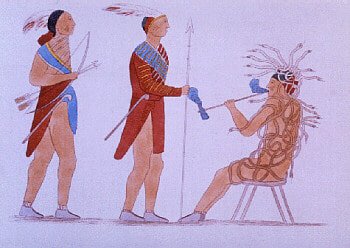MNN. THE SERPENTS ARE TRYING TO RETURN. WE ARE STOPPING THEM. . 24, 2025. McGill University Law School.
We are here on the land of the Kaniekehaka Mohawks at the foot of Mount Royal in tiotiakeh Montreal. The bear clan village of tekanontak stood right here and where we are told the serpents did away with our people and hid their outrageous actions from the world. Today we are looking for our babies. We, the “Keepers of the Eastern Door”, stood on this original Mohawk village watching for invasive species and slithering serpents.
The adodarho is the position of the chairman in the Iroquois Confederacy, He is the “fire keeper” at onondaga, the capital of the Iroquous confederacy near Syracuse New York. An attempt is being made by these serpents to confuse our current adodarho to try to go back to the time before dekanawida, our great peacemaker, who formed an alliance of our five rotinoshonni Iroquoian peoples and provided us our prophecies. The chiefs, clan mothers and children stand around him and are a protective wall. The confederacy can only be an ally of peace, never war.
This is an old story of the rotinoshonni Iroquois. Before he became a man of peace adodarho’ had a “twisted body” and could kill his enemies from a distance without seeing them. He had serpents coming out of his hair. He was in great pain. Everybody was scared of him. He enjoyed being cruel. He ruled with hate, fear and threats and was considered to be a sorcerer. He wanted to dominate wherever he was. After much conflict, he was eventually transformed from being a tyrant who always wanted war into a symbol of peace by dekanawida the Peacemaker and ayonwentha, by removing all the serpents from his brain.
Who is dekanawida? He came to us to tell us three things, the good message, the power and the peace. 1. ON THIS PLANET ALL LIVING THINGS HAVE THE SAME MOTHER, SHE IS THE EARTH. THE SAME FATHER, WHICH IS THE SOURCE ENERGY OF ALL CREATION THAT MAKES US ALL BROTHERS AND SISTERS. WE SHALL SURVIVE AND COEXIST AS SUCH. 2. THE POWER IS IN OUR OWN MINDS WHERE A PIECE OF THE SOURCE ENERGY OF CREATION HAS BEEN PLACED THAT GIVES US OUR POWER. 3.THE GREAT PEACE IS THE KAIANEREKOWA, WHEREBY WE SHALL SURVIVE AND CO-EXIST WITH EACH OTHER AND ALL OF NATURE, PERPETUALLY FOREVER’.
 We are now entering a time where the serpents have returned trying to slither their way into the confederacy to abuse the natural world. We will not let this happen. Some of these serpents are in the form of smooth talking and very aggressive politicians. We the kanienkehaka Mohawks, known as the “flint people”, were assigned to discern these lying deceitful spirits that are coming. We do not listen to their lies to seduce our people from the true message of dekakanawida.
We are now entering a time where the serpents have returned trying to slither their way into the confederacy to abuse the natural world. We will not let this happen. Some of these serpents are in the form of smooth talking and very aggressive politicians. We the kanienkehaka Mohawks, known as the “flint people”, were assigned to discern these lying deceitful spirits that are coming. We do not listen to their lies to seduce our people from the true message of dekakanawida.
Before dekanawida came we were constantly at war with each other. Adodarho had instigated hatred between the people. Dekanawida lifted the black cloud of hatred hovering over us. The serpents are seeking power and want to sit in that seat in onondaga, the capital of the confederacy, the alliance, with their new head dresses with serpents coming out of it.
The source of peace in the entire world started in onondaga when the peace maker came there from the sky world. We will not allow the confederacy to go back to the evil driven mind of adodarho’s hatred. Whoever sits in that seat will try to conquer the world. They want the evil power he had before the serpents were removed. There are many vying for that position.
Adodarho was charismatic and could draw people to himself. At first the Europeans who came to turtle island were supposed to make a constitution based on the kaianerekowa great peace called the great path, which failed. Our way provides that they were to help us to convert the world to the great peace. [1701, 1710, 1923]. Otherwise they could not remain here. The US, UN and League of Nations were all phoney corporations acting as phoney confederations and now are in the process of falling. They don’t have the true spirit of peace of dekanawida..
Adodarho was cured by using a combination of ritual and physical actions to heal his mind and body to remove the serpents. After consulting with Jigonhsasee, the Mother of of our people, ayonwentha combed the serpents from his matted hair and sang a melody of peace to him which transformed him. Dekanawida massaged his crooked body with herbs and wampum, smoothing out the seven bends on his body. This healing lead to establishing the kaianerekowa great peace and his becoming the keeper of the central fire of the alliance at of the Iroquois peoples at onondaga. The women provided adodarho with new robes and placed an antler headdress on his head, symbolizing the renewed goal for peace and a shift from his past.
How did adodarho accept to be peaceful. When someone is in great pain they can mistreat people. He killed children. He was very sick. But he was cured because the people wanted him to be cured. Don’t make him mad otherwise more danger would come our way.
Adodarho helped dekanawida to unify the rotinoshonni nations into the Five Nations Confederacy, creating the principles of peace and justice of the kaianerekowa great peace which is the model for participatory democracy.
 The serpents are trying to come back. They want to create one body that will run the world that everybody will bow down to, instead of participate in as equals. The Iroquois and their allies will once again stand against this evil that is now trying to take over the Confederacy and the world. We will honor the peace message of dekanawida to stand against this evil power that is trying to control people for evil purposes. When the Grand Council passes the message over the fire, it will go to creation and an answer will return telling us how to fight this evil. No one can pervert dekanwida’s message of peace into a message of war. Creation will tell us how to bring back the peace, which constantly remains in our minds.
The serpents are trying to come back. They want to create one body that will run the world that everybody will bow down to, instead of participate in as equals. The Iroquois and their allies will once again stand against this evil that is now trying to take over the Confederacy and the world. We will honor the peace message of dekanawida to stand against this evil power that is trying to control people for evil purposes. When the Grand Council passes the message over the fire, it will go to creation and an answer will return telling us how to fight this evil. No one can pervert dekanwida’s message of peace into a message of war. Creation will tell us how to bring back the peace, which constantly remains in our minds.
In the 1970s a group of young Mohawk kanienkehaka people of Akwesasne and Kahnawake called the “white roots of peace” travelled throughout turtle island to carry the the warn to our families of the peril that was encircling turtle island.
The world wants real peace. Right now the empire of the three city states, London. Vatican and Washington DC are trying to run everything, like the old adodharo, so they can be crowned the rulers of the world. Their masks are coming off and we are beginning to see them. Time is circular. Right now we see elements of this story about the old evil atotarho unfolding in front of us.
We must look to the past to see what we can do in the present. Today the reformed adodarho remains peaceful and presides over the Grand Council fire of the Rotinishonni Confederacy at Onondaga.
The sweeping serpents hairstyle of his hair once symbolized the inner turmoil of his twisted mind and body. He always wanted chaos and lawlessness. When somebody suggested peace, he killed them. He was poisoned by hatred. During the formation of the confederacy the serpents were combed out. He transformed from a source of evil to the keeper of the council fire of peace. He carried a message of peace from creation. Jigosasne, a woman, was the first clan mother to stand by dekanawida. In a short time all 9 clans of the kanienkehaka Mohawk were stood up by dekanawida, which is the real bloodline that we follow, not the serpentines from Europe.
The West is now in free fall. They face disapproval, losing credibility, declining support, failing economy, distraction through threatened military escalation, weak government, questionable justice and almost no accountability. Dekanawida and ayonwentha may return to get rid of the serpents. Trump wants to sit in the center of turtle island and order everybody around. We use different ways to take the serpents from the minds of people like this. People are being mesmerized and controlled through fear. Indigenous know that whatever you fear you will realize. Dekanawida told us there would be 3 serpents. First white, then red and at the end black. We are now in the time of the black serpent.. The Epstein bombshell should be the undoing of the current administration. But as the blind man says, “We shall see” their undoing. The US is having a hard time hiding their misdemeanours. We are all under attack. We indigenous are placed here by nature to care for our mother earth and are suppose to confront these monsters. They want to replace us with AI Artificial Intelligence created subhumans. MKULTRA and other mind control projects are under the same fear mongering. We look to the kasatstensera kowa sa oiera, the great natural power, and to heal through our ceremonies, songs, stories and words.
Some of you may not be sure who you are, having come from many lands and put into hypnotic states to get control of your minds. We are actually the opposite of your kings, queens and corporate systems. We are the sovereigns of turtle island who have original instructions to be the caretakers of turtle island and to those who live according to the kaianerekowa, the great peace.
Once the message of peace begins it is unstoppable. We are the oldest living democracy on the planet. We will not be silent about our grief for the land. We ask you to give back to our mother earth and have a healthy relationship with her. We refuse to despair or be paralyzed by it. Our land is crying out for our help. Let’s repair her and our relationship. We all want to be closer to our mother earth.
Since your arrival on onowarekeh turtle island, we have been victims of genocide. But we are still here.
The Beatles arrived from Liverpool to warn the world of the potential coming as they sing HELP:
youtube.com/watch?v=2Q_ZzBGPdqE&list=RD2Q_ZzBGPdqE&start_radio=1
#991 kahnawake Qc. Canada
WHAT COULD HAPPEN WHEN HUMANS ARE DEAD:
MCGILL U. THE MOHAWK UNITY FLAG: A CONVERSATION
https://www.thetribune.ca/news/the-unity-flag-a-conversation-with-tekarontakeh-25112025/











 By Mohawk Artist Star Horn
By Mohawk Artist Star Horn

















